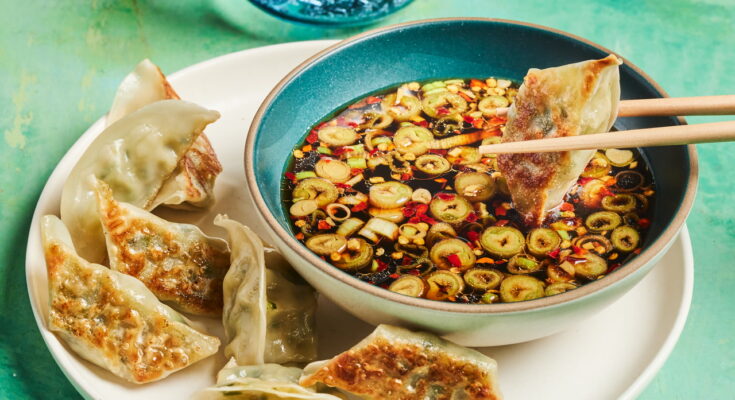Gyoza Sauce Recipe: Gyoza sauce is a simple yet flavorful dipping sauce traditionally served with Japanese dumplings, known as gyoza. It strikes the perfect balance between salty, tangy, and slightly sweet notes, making it an essential complement to the savory dumpling filling. At its core, this sauce is made with soy sauce, rice vinegar, and a touch of sesame oil, though variations exist depending on personal preferences. The beauty of gyoza sauce lies in its versatility—it’s quick to prepare, requires minimal ingredients, and can easily be adjusted to suit different taste preferences.
Think of gyoza sauce as the “finishing touch” that brings dumplings to life. Without it, gyoza might taste good, but with it, the flavors are elevated to a whole new level. The sauce enhances the umami-rich dumplings, adding brightness and depth. While you can buy pre-made dipping sauces, nothing beats the freshness of a homemade version where you control the ingredients.
Why Homemade Gyoza Sauce is Better Than Store-Bought
Store-bought gyoza sauces often contain preservatives, artificial flavors, and excess sodium, which can overpower the natural flavor of dumplings. Making the sauce at home not only gives you control over the ingredients but also lets you customize the taste. Prefer a spicier kick? Add chili oil. Want a sweeter balance? A dash of honey works wonders. Plus, homemade sauce is cost-effective—you can make a large batch for a fraction of the price of bottled sauces.
Most importantly, homemade gyoza sauce feels more authentic. It allows you to play with traditional Japanese flavors while tailoring them to your taste buds. Once you try making it yourself, you’ll never look back at store-bought versions again.
Ingredients You’ll Need
Essential Pantry Ingredients
To make the classic gyoza dipping sauce, you’ll need just a few staple ingredients:
- Soy Sauce – the salty, umami-rich base.
- Rice Vinegar – provides tanginess and balances the saltiness.
- Sesame Oil – adds nutty aroma and depth.
These three create the foundation of gyoza sauce. Their flavors blend harmoniously to create that signature balance between savory, sour, and aromatic notes.
Optional Add-Ins for Extra Flavor
Once you’ve nailed the base, you can enhance the sauce with optional ingredients:
- Chili Oil or Chili Flakes – for a spicy kick.
- Minced Garlic or Ginger – adds warmth and sharpness.
- Sugar or Honey – balances tanginess with sweetness.
- Green Onions – provides freshness and color.
These add-ins are not necessary but can elevate your sauce to match restaurant-style versions.
Choosing the Right Soy Sauce and Vinegar
Not all soy sauces are created equal. For gyoza sauce, light soy sauce works best since it offers saltiness without overwhelming the flavor. Avoid dark soy sauce unless you prefer a stronger taste. As for vinegar, rice vinegar is the traditional choice because of its mild and slightly sweet profile. Substituting with white vinegar or apple cider vinegar may alter the flavor significantly, so stick to rice vinegar for authentic taste.
Tools and Equipment Required
Mixing Bowls and Measuring Tools
Making gyoza sauce doesn’t require fancy equipment. A simple mixing bowl and a spoon are enough. For precision, measuring spoons help you maintain the right balance between soy sauce and vinegar.
Storage Containers for Leftovers
If you’re making a bigger batch, airtight glass jars or condiment bottles are ideal for storage. Glass preserves flavor better than plastic and prevents odor absorption. Proper storage ensures your sauce tastes fresh for days.
Step-by-Step Guide to Making Gyoza Sauce
Step 1 – Gather All Ingredients
Before starting, ensure you have all the ingredients measured and ready. This saves time and keeps the process smooth. A basic ratio to follow is:
- 2 tablespoons soy sauce
- 2 tablespoons rice vinegar
- 1 teaspoon sesame oil
This is your base recipe.
Step 2 – Mix the Base Ingredients
In a small bowl, combine soy sauce, rice vinegar, and sesame oil. Stir gently until everything blends. The result should be a thin, dark sauce with a glossy sheen and a balance of salty and tangy notes.
Step 3 – Adjust the Flavor Balance
Taste your sauce. If it feels too salty, add a splash more rice vinegar. If it’s too tangy, balance it with a pinch of sugar. This step is all about fine-tuning to your taste preference.
Step 4 – Add Optional Spices and Aromatics
If you enjoy spice, add a teaspoon of chili oil or a sprinkle of chili flakes. For extra depth, mix in minced garlic or ginger. These ingredients intensify the flavor and give the sauce a restaurant-style kick.
Step 5 – Serve Fresh or Store for Later
Pour the sauce into small dipping bowls and serve alongside freshly cooked gyoza. If you have leftovers, store them in a sealed jar in the refrigerator for up to a week.
Variations of Gyoza Sauce
Spicy Gyoza Sauce with Chili Oil
If you love a bit of heat, then spicy gyoza sauce is the way to go. The easiest way to achieve this is by adding chili oil or chili flakes to the base recipe. Chili oil infuses the sauce with a smoky, spicy flavor that pairs perfectly with juicy dumplings. Start with a teaspoon and adjust according to your spice tolerance. For those who want an extra fiery kick, sprinkle in crushed red pepper or even a dash of sriracha.
What makes spicy gyoza sauce stand out is the depth it brings. The chili oil not only adds heat but also a subtle richness thanks to the infused sesame and garlic flavors. It turns a simple dip into a bold, flavorful condiment that can rival restaurant-style sauces. Pro tip: drizzle a few drops over your gyoza right before eating instead of mixing everything in at once—you’ll get little bursts of heat with every bite.
Garlic-Infused Gyoza Sauce
Garlic lovers, this one’s for you. Adding minced fresh garlic or lightly sautéed garlic to the sauce transforms it into a powerhouse of flavor. The garlic blends beautifully with soy sauce and vinegar, enhancing the umami and giving the dip a more robust character.
If raw garlic feels too strong, you can roast or sauté it in a touch of sesame oil before mixing it into the sauce. Roasting mellows out its sharpness and introduces a subtle sweetness. Garlic-infused gyoza sauce is especially great when paired with pork or chicken gyoza, as the flavors complement the meat perfectly.
Sweet and Tangy Gyoza Sauce
For those who prefer a milder, more balanced dip, adding a touch of sugar or honey creates a sweet and tangy gyoza sauce. This variation is kid-friendly and works well with vegetable or seafood dumplings. The sweetness cuts through the saltiness of soy sauce and softens the tang of vinegar, resulting in a smoother, more approachable flavor profile.
You can also experiment with mirin (a sweet Japanese rice wine) instead of sugar—it adds sweetness while keeping the flavor authentic. The combination of sweet, salty, and tangy notes makes this version perfect for people who want a lighter dipping experience without sacrificing taste.
Tips for Perfect Gyoza Dipping Sauce
Balancing Salty, Sour, and Sweet Notes
The magic of gyoza sauce lies in balance. Too much soy sauce makes it overly salty, while too much vinegar can make it too sharp. The key is to aim for harmony. A general rule of thumb is a 1:1 ratio of soy sauce to rice vinegar, then adjust depending on your taste. Adding just a pinch of sugar can tie everything together, softening the edges of the salty and sour notes.
Taste as you go. A quick dip with a dumpling will tell you instantly if you need more acidity or sweetness. Remember, gyoza fillings can vary—pork dumplings may need more vinegar to cut through the richness, while veggie dumplings might benefit from a bit more soy sauce.
Pairing with Different Types of Gyoza
Not all gyoza are created equal, and your sauce should complement the filling:
- Pork Gyoza – Needs more vinegar to balance fat.
- Chicken Gyoza – Pairs well with garlic or ginger in the sauce.
- Vegetable Gyoza – Benefits from a sweeter sauce with a hint of sesame oil.
- Seafood Gyoza – Works best with spicy or citrusy additions like yuzu or lemon juice.
Adjusting the sauce based on the filling makes the overall experience more enjoyable and shows how versatile this simple recipe can be.
Serving Suggestions
Traditional Pairings with Gyoza Dumplings
Of course, gyoza sauce was made for dumplings. Serve it in small dipping bowls alongside freshly pan-fried gyoza for an authentic Japanese dining experience. The sauce also works great for steamed gyoza, offering that contrast of light dumpling skins with bold, tangy flavor.
For a full meal, pair gyoza with miso soup, rice, and pickled vegetables. The sauce ties the meal together, acting as both a dip and a flavor booster for side dishes.
Creative Uses Beyond Dumplings
While traditionally meant for gyoza, this sauce is far too delicious to be limited to dumplings. You can use it in:
- Stir-fries – Add a splash to veggies or noodles for quick flavor.
- Marinades – Use as a marinade for chicken, beef, or tofu.
- Salad Dressing – Mix with a little extra sesame oil for an Asian-inspired dressing.
- Spring Rolls and Sushi – Works as a dipping sauce beyond gyoza.
Once you realize how versatile it is, you’ll find yourself making bigger batches just to have it handy for multiple dishes.
Storage and Shelf Life
Refrigeration Tips
Homemade gyoza sauce should always be stored in an airtight container in the refrigerator. Glass jars are ideal since they preserve freshness better than plastic. Typically, the sauce stays good for up to 7 days in the fridge.
Before using it again, give it a quick stir since some ingredients may settle at the bottom.
Freezing for Long-Term Use
If you want to make a larger batch, freezing is also an option. Pour the sauce into ice cube trays, freeze, then transfer to a freezer-safe bag. This way, you can thaw small portions as needed. Frozen gyoza sauce can last up to 2 months without losing much flavor.
Nutritional Value of Gyoza Sauce
Calories and Macronutrients
One of the great things about gyoza sauce is that it’s naturally light. Since it’s made mostly of soy sauce, vinegar, and sesame oil, the calorie count per serving is very low—typically around 15–25 calories per tablespoon. Most of these calories come from the sesame oil, which also provides healthy fats. Soy sauce contributes a small amount of protein, while rice vinegar is virtually calorie-free.
However, it’s worth noting that soy sauce is high in sodium. Just one tablespoon can contain up to 900 milligrams of salt, which is nearly 40% of the recommended daily intake. That’s why moderation is key, especially if you’re watching your sodium levels. If you’re health-conscious, you can opt for low-sodium soy sauce without sacrificing too much flavor.
Healthier Substitutions
If you want to make your gyoza sauce a bit healthier, here are some smart swaps:
- Low-Sodium Soy Sauce – Cuts down on salt without losing umami.
- Coconut Aminos – A soy-free alternative that’s naturally sweeter and lower in sodium.
- Apple Cider Vinegar – Can replace rice vinegar for a sharper, more tangy flavor.
- Olive Oil Instead of Sesame Oil – Not traditional, but a heart-healthy option.
With these substitutions, you can enjoy gyoza sauce more frequently without feeling guilty about your sodium or calorie intake.
Common Mistakes to Avoid
Overpowering Flavors
The beauty of gyoza sauce lies in its simplicity, but it’s easy to go overboard with add-ins. Too much chili oil can drown out the other flavors, while too much garlic can make the sauce bitter. Always start with small amounts of extras, taste, and adjust gradually. Remember, you can always add more, but you can’t take it out once it’s mixed.
Incorrect Ingredient Ratios
The classic soy sauce-to-vinegar ratio is 1:1, and for good reason—it keeps the saltiness and tanginess balanced. Using too much soy sauce makes the sauce overly salty, while too much vinegar turns it too sour. Another common mistake is adding too much sesame oil. While it’s a great flavor booster, it should be used sparingly; otherwise, it can dominate the sauce and make it greasy.
When in doubt, stick to the basics and adjust little by little until the sauce matches your taste.
FAQs about Gyoza Sauce Recipe
1. Can I make gyoza sauce without soy sauce?
Yes, you can substitute soy sauce with coconut aminos or tamari for a gluten-free option. Coconut aminos are naturally sweeter, so you may want to reduce any added sugar.
2. How long does homemade gyoza sauce last?
When stored in an airtight container in the fridge, gyoza sauce lasts about one week. For longer storage, you can freeze it in small portions for up to two months.
3. What can I substitute for rice vinegar?
If you don’t have rice vinegar, you can use apple cider vinegar or white wine vinegar. Keep in mind that these are stronger in flavor, so use a little less than the recipe calls for.
4. Can I use this sauce for noodles?
Absolutely! Gyoza sauce works wonderfully as a quick noodle dressing. Add it to cold soba noodles, stir-fried udon, or even ramen for a boost of flavor.
5. How do I make the sauce less salty?
The easiest way is to use low-sodium soy sauce. You can also dilute the sauce with a splash of water or balance it with extra vinegar and a touch of sweetness.
Conclusion
Gyoza sauce may seem simple, but it’s the secret weapon that turns a plate of dumplings into an unforgettable meal. With just three basic ingredients—soy sauce, rice vinegar, and sesame oil—you can create a dipping sauce that perfectly balances salty, tangy, and nutty flavors. From there, you can customize it with garlic, chili oil, or even a touch of sweetness to make it your own.
What makes gyoza sauce truly special is its versatility. Yes, it’s perfect for dipping dumplings, but it’s also great as a marinade, stir-fry sauce, or salad dressing. Plus, it’s quick, budget-friendly, and healthier when made at home. By following this step-by-step guide, you’ll never need store-bought versions again.
So the next time you prepare dumplings, don’t forget the sauce—it’s the finishing touch that brings everything together.



